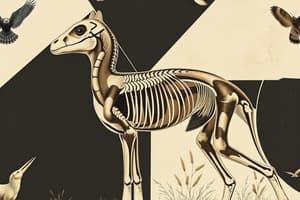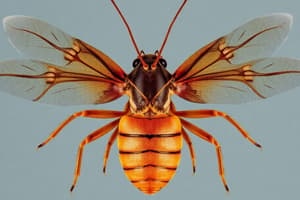Podcast
Questions and Answers
What is the primary function of CamScanner?
What is the primary function of CamScanner?
- To scan documents (correct)
- To manage emails
- To create presentations
- To edit videos
Which feature is typically NOT associated with CamScanner?
Which feature is typically NOT associated with CamScanner?
- Text recognition
- Cloud storage integration
- Video conferencing (correct)
- Document sharing
How does CamScanner improve image quality?
How does CamScanner improve image quality?
- By auto-cropping and enhancing clarity (correct)
- By filtering colors
- By adjusting brightness levels
- By applying sound effects
What file formats can CamScanner typically export documents to?
What file formats can CamScanner typically export documents to?
Which of the following is a benefit of using CamScanner over traditional scanners?
Which of the following is a benefit of using CamScanner over traditional scanners?
Flashcards
CamScanner
CamScanner
A mobile application for scanning documents and converting them to digital formats.
Study Notes
Kingdom Animalia
- Divided into 3 subkingdoms: Protozoa, Parazoa, and Metazoa
- Protozoa: includes one-celled animals
- Parazoa: includes simple multicellular animals like sponges
- Metazoa: includes the rest of animals, more complex multicellular animals with complex organ systems
Symmetry in Animals
- Symmetric animals can be divided into two identical halves by a straight line
- Asymmetric animals cannot be divided into identical halves by a straight line
- Different types of symmetry exist: radial, spherical, and bilateral
Animal Taxonomy
- Animal Taxonomy: a branch of Zoology related to identifying, describing, naming, and classifying different animal species
- Aristotle classified animals based on:
- Presence or absence of red blood (Enaima or Anaima)
- Type of environment they live in (terrestrial, aquatic, aerial)
- Type of food they eat (carnivorous, herbivorous, or carni-herbivorous)
John Ray
- Established the idea of classifying animals based on morphological characteristics
- Defined species as groups of animals that are morphologically similar and interbreed freely, but cannot interbreed with other groups, and if they do the offspring are sterile
Linnaeus
- Created a new classification system based on morphological and anatomical features
- Introduced binomial nomenclature (Genus and species) as a method for naming animals (written in italics or underlined)
Modern Systematic Zoology
- Animal classifications are not only based on morphological and anatomical characteristics, modern methods include biochemical, genetic, and physiological features
Animal Taxa
- Species: group of similar animals that can produce fertile offspring
- Genus: species grouped by similar characteristics.
- Family: genera that grouped by similar characteristics.
- Order: families with common features are grouped into one order
- Class: related orders with common features are grouped into one class.
- Phylum: related classes grouped into one phylum
- Kingdom: Related phyla are grouped into one kingdom
Trypanosoma gambiense
- A parasitic protozoan
- Causes African trypanosomiasis (sleeping sickness)
- Affects the human host by invading brain tissue, consuming excessive glucose, and producing toxins
Entamoeba histolytica
- Protozoan parasite
- Causes amoebiasis (often an intestinal disease)
Plasmodium spp.
- Contains several species that cause malaria
Sporongospora subterranea
- A parasite of plants
Plasmodiophora brassicae
- A parasite of plants
Studying That Suits You
Use AI to generate personalized quizzes and flashcards to suit your learning preferences.




